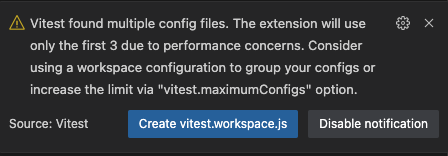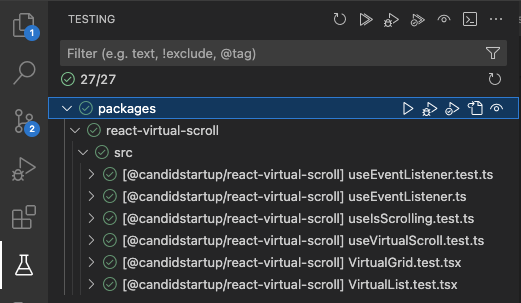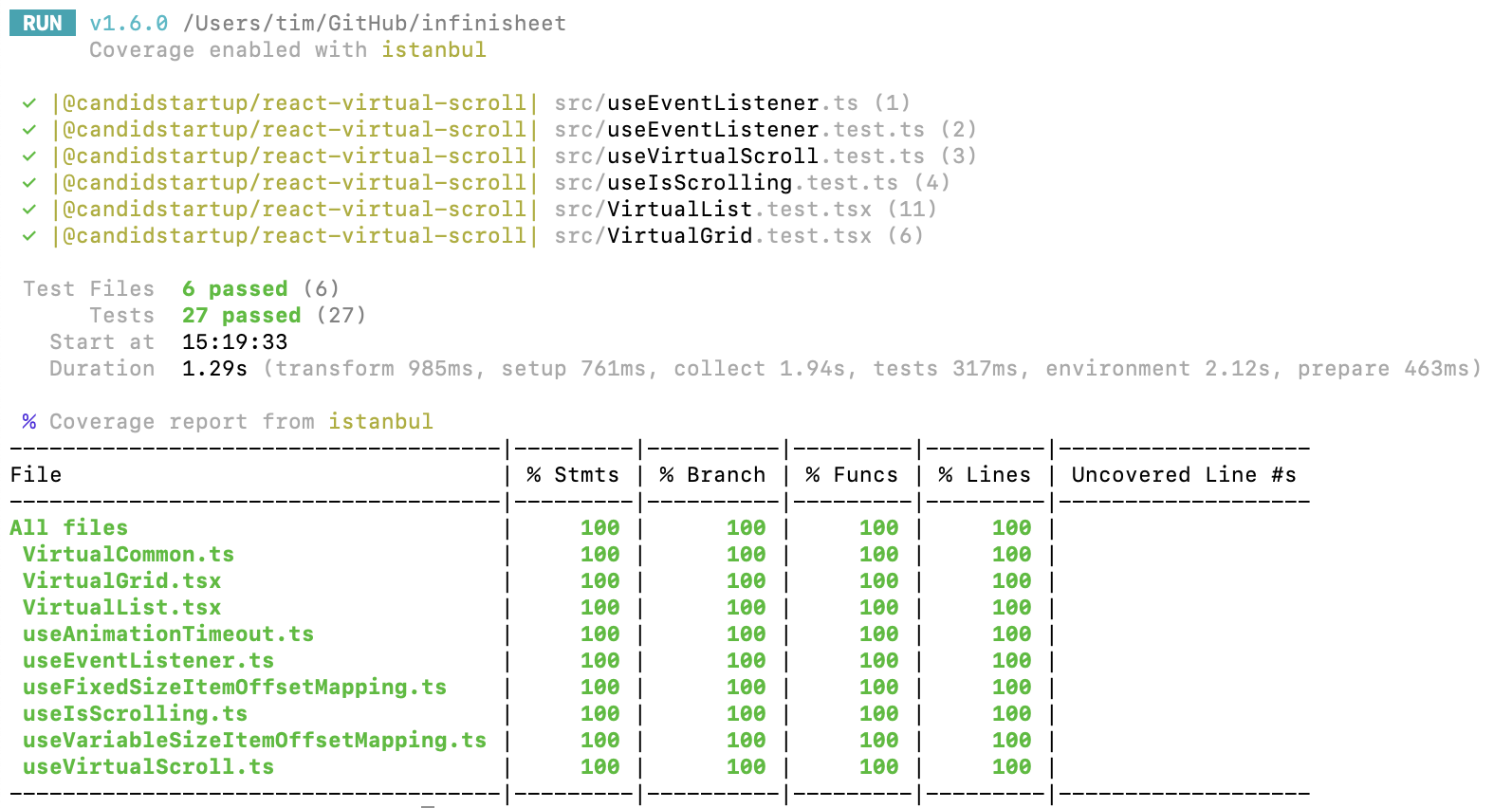I was about to get started turning my stub react-spreadsheet package into a real one, when I noticed a new Vitest related warning from VS Code.
This post describes monorepo setup for Vitest 1.6 - 2.x. The workspace feature described here was deprecated in Vitest 3.2.
There is an updated version of this post for Vitest 3 and later.


Vite Config Files
Which reminded me that I haven’t done anything to better structure my vite.config.ts file for a monorepo. Vitest is built on Vite and conveniently uses the same config file. I currently have an independent config for each app and package with no attempt to share common settings.
App and package configs are very different. My virtual-scroll-samples app config is mainly concerned with producing a production build of the app. There are no Vitest settings.
import { defineConfig } from 'vite'
import react from '@vitejs/plugin-react-swc'
import tsconfigPaths from 'vite-tsconfig-paths'
import sourcemaps from '@gordonmleigh/rollup-plugin-sourcemaps'
import { resolve } from 'path'
export default defineConfig({
plugins: [
react(),
tsconfigPaths()
],
build: {
sourcemap: true,
rollupOptions: {
plugins: [sourcemaps()],
input: {
main: resolve(__dirname, 'index.html'),
"list-and-grid": resolve(__dirname, 'samples/list-and-grid/index.html'),
"trillion-row-list": resolve(__dirname, 'samples/trillion-row-list/index.html'),
"trillion-square-grid": resolve(__dirname, 'samples/trillion-square-grid/index.html'),
"horizontal-list": resolve(__dirname, 'samples/horizontal-list/index.html'),
"paging-functional-test": resolve(__dirname, 'samples/paging-functional-test/index.html'),
"spreadsheet": resolve(__dirname, 'samples/spreadsheet/index.html'),
"padding": resolve(__dirname, 'samples/padding/index.html'),
},
output: {
manualChunks: (id) => {
if (id.includes('node_modules')) {
return 'vendor';
}
}
}
}
}
})
In contrast, my react-virtual-scroll package config is mostly made up of Vitest settings.
import { defineConfig } from 'vite'
import { configDefaults } from 'vitest/config'
import react from '@vitejs/plugin-react-swc'
export default defineConfig({
plugins: [react()],
test: {
globals: true,
includeSource: ['src/**/*.{js,ts}'],
environment: 'jsdom',
setupFiles: './src/test/setup.ts',
coverage: {
provider: 'istanbul',
include: ['src/**'],
exclude: ['src/test/**'],
},
fakeTimers: {
toFake: [...(configDefaults.fakeTimers.toFake ?? []), 'performance'],
},
},
define: {
'import.meta.vitest': 'undefined',
},
})
I copied the react-virtual-scroll config when I created the react-spreadsheet stub package. It would be great if I can hoist all the common settings up to the workspace level. Searching for “Vitest Workspace” took me straight to the documentation.
Vitest supports an explicit workspace level config for monorepo setups. As far as I can tell, there’s no equivalent for Vite. I’m going to concentrate on sharing the Vitest settings as the rest of the config file is pretty much a stub anyway.
Workspace Config
You enable Vitest’s workspace mode by creating a vite.workspace.ts file in your workspace’s root directory. The simplest workspace config just tells Vitest where to look for each project.
import { defineWorkspace } from 'vitest/config'
export default defineWorkspace([
'packages/*'
])
I assumed that you could put common config into the workspace file and then run Vitest per package as normal. I was wrong on both counts.
If you run Vitest in the package directory it runs as before, ignoring the workspace file. The workspace file is only used if you run Vitest in the root directory. It then checks each package directory for a Vite or Vitest config file, loads all the tests from all the packages and executes them together.
You can put config into the workspace file but it behaves just like a per-package config file. This isn’t shared config, just an alternative place to define test projects. I’m not sure why you’d want to do this. It’s much easier to maintain package specific settings in a dedicated file in each package directory.
Global Settings
It gets more confusing. The documentation explains that some settings, like coverage, apply globally at the workspace level. Fine, I’ll move those settings into the workspace file.
Wrong again. The configs in the workspace file are per-package config, not workspace level config! You have to put your coverage options into a separate vitest.config.ts file in the root directory. This isn’t documented but is covered in a Q&A discussion.
Annoyingly, coverage at the workspace level ignores the definition of packages in the workspace file. You have to explicitly specify what to include.
export default defineConfig({
test: {
coverage: {
provider: 'istanbul',
include: ['packages/*/src/**'],
exclude: ['packages/*/src/test/**'],
},
},
})
Taking Stock
At this point I’ve done enough to fix the VS Code warning. The Vitest plugin uses the workspace file to load tests from all packages. I can run all the tests, run tests for a selected package or individually. Seems to work fine.


I can also run coverage for the entire workspace in one go. I’ll need multiple real packages to see whether this is quicker than running coverage for each package as I do now. Both ways work, so that’s nice.


Shared Testing Code
My existing react-virtual-scroll package has three files of common testing code in src/test.
setup.ts: a Vitest setup file that automatically makes Jest DOM assertions available for use in each testwrapper.tsx: a wrapper around@testing-library/reactthat I copied from an official Vitest exampleutils.ts: my own set of utility functions
Moving them out from under react-virtual-scroll/src means updating all the import statements that reference them and updating the TypeScript tsconfig.json to include them in the set of files processed by the compiler.
My first thought was to add them to my root tsconfig.json which the per-package tsconfig.json extends. Unfortunately, that doesn’t work because any property in the per-package config overrides that in the root, even if it’s an array property. Arrays aren’t merged.
I had to add test to the include array in each per-package stub config.
{
"extends": "../../tsconfig.json",
"include": ["src", "../../shared/test"]
}
Shared Vite Config
The workspace documentation has a separate section on sharing config. You need to put your shared config in a separate file and then import it and use the mergeConfig utility to combine with your per-package config. Interestingly, mergeConfig seems to be generic. It appears to work with Vite settings too.
I was expecting another misunderstanding on my part, but it worked as expected. I was able to move almost everything into a shared vitest.config.ts. I’ve left the old coverage settings in place so that I can still run per package coverage.
import { defineConfig } from 'vite'
import { configDefaults } from 'vitest/config'
export default defineConfig({
test: {
globals: true,
includeSource: ['src/**/*.{js,ts}'],
environment: 'jsdom',
setupFiles: '../../shared/test/setup-jsdom.ts',
coverage: {
provider: 'istanbul',
include: ['src/**'],
exclude: ['src/test/**'],
},
fakeTimers: {
toFake: [...(configDefaults.fakeTimers.toFake ?? []), 'performance'],
},
},
define: {
'import.meta.vitest': 'undefined',
},
})
I could then pull the shared config into a per-package stub. I left the React plugin in my per package config as I’ll have a mix of React and vanilla TypeScript packages. If needed, I can have a whole cascade of common configs for different scenarios.
import { defineConfig } from 'vite'
import { mergeConfig } from 'vitest/config'
import configShared from '../../shared/vitest.config'
import react from '@vitejs/plugin-react-swc'
export default mergeConfig(
configShared,
defineConfig({
plugins: [react()],
})
)
Conclusion
That was more confusing than it needed to be, but I seem to have ended up in a reasonable place. The VS Code warning has gone, I have a system for managing shared Vite and Vitest settings, and I have the option of running unit tests and coverage either per package or for the entire workspace at once.